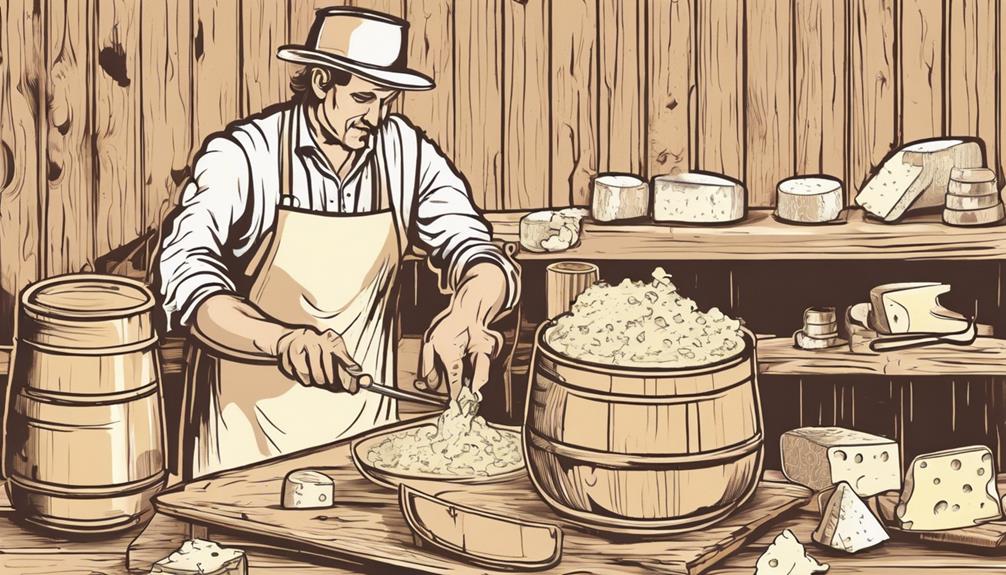How To Become More Self-Sufficient Without Starting a Full-Blown Farm…
Want to start preserving your harvest, making your own soap, or building a backyard root cellar — but not sure where to begin? “Homesteading Advice” gives you instant lifetime access to 35+ practical homesteading books on food preservation, veggie gardening, DIY natural cleaning products (save over $250 per year with this skill alone), brewing, off-grid energy, and a whole lot more…
Click Here To Check It Out Now!
“Hey, I’m making cheese at home and I’ve started noticing random holes and cracks in my cheese batches. They seem somewhat irregular and I’m not sure what’s causing them. Any insights would be super helpful!” Thanks, Anna, Melbourne, Australia.
What Causes Holes or Cracks in Cheese?
Hey Anna! It’s wonderful to see someone diving into the world of cheese making. It’s a craft that combines art and science in the best ways. Let’s break down what might be causing those pesky holes and cracks in your cheese so you can perfect your batches.
Understanding the Basics
Cheese is a complex creation involving milk, bacteria, rennet, and sometimes molds. Each component plays a critical role in the final texture and appearance of the cheese. Holes and cracks can form due to a variety of factors, ranging from bacterial activity to environmental conditions during aging.
Types of Holes in Cheese
Firstly, it’s important to recognize that not all holes in cheese are unwanted. In certain types of cheese like Swiss cheese, holes (also known as “eyes”) are a desirable characteristic. These holes are formed by carbon dioxide gas released by specific bacteria as they consume lactic acid.
Beneficial Holes
- Propionic Bacteria: In cheeses such as Emmental or Gruyère, Propionibacterium freudenreichii is intentionally added. These bacteria consume lactic acid and release carbon dioxide during their activity, forming the familiar round holes.
Unwanted Holes and Cracks
On the other hand, irregular or unwanted holes and cracks can be the result of several different issues:
Bacterial Imbalance
- Contaminant Bacteria: Unwanted bacterial contamination can lead to irregular holes. These contaminant bacteria might produce excessive gas, leading to large, irregular holes.
- Temperature Fluctuations: If the cheese’s temperature isn’t controlled properly, it can stress the bacteria, resulting in inconsistent gas production and holes.
Moisture Content
- High Moisture: When the curds retain too much whey, the moisture content of the cheese becomes higher than desired. High moisture can lead to unwanted fermentation, which might cause undesired gas formation and hole development.
- Low Moisture: Conversely, overly dry curds can lead to cracks in your cheese. This happens because the cheese becomes brittle instead of having a supple, bendable texture.
Curing and Aging Factors
- Inconsistent Humidity: Proper humidity levels are crucial during the aging process. Too low humidity can cause the cheese to dry out and crack, while too high humidity can lead to excessive microbial activity and gas production.
- Temperature Control: Maintaining a steady, appropriate temperature is paramount during aging. Fluctuations can stress the cheese structure, leading to cracks or holes.
Handling and Pressing
How the curds are handled and pressed during cheese making can also contribute to these issues:
- Insufficient Pressing: Not applying enough pressure during pressing can trap air pockets in the cheese, leading to holes.
- Over-pressing: On the flip side, too much pressure can expel too much whey and make the cheese overly dry, causing cracks.
- Curd Cutting: Cut curds uniformly. If the curd size is inconsistent, it can lead to poor curd bonding and holes.
Preventive Measures
Now, let’s talk about how to prevent these issues, Anna. Here are some useful strategies:
Proper Hygiene and Sanitation
- Always ensure your equipment and tools are well sanitized. Any contamination can impact the cheese-making process significantly.
- Work in a clean environment to minimize the risk of introducing unwanted bacteria.
Controlling Moisture Content
- Drain the whey adequately. Depending on the type of cheese, follow specific guidelines on whey drainage.
- Adjust pressing techniques according to the moisture requirement of the cheese variety you’re making.
Maintaining Temperature and Humidity
- Use a cheese cave or a dedicated refrigerator with controlled temperature and humidity settings for aging.
- Regularly monitor and maintain consistent conditions to prevent unnecessary stress on the cheese.
Exploring Examples
Let’s consider a practical example. Suppose you’re making a semi-hard cheese like Gouda. If you observe irregular holes, it might be due to:
- Inconsistent curd size during cutting.
- Fluctuating temperatures during the initial fermentation.
- Inadequate pressing leading to trapped air pockets.
For cracks, another example could be when making Cheddar:
- If your environment is too dry, the cheese might lose moisture too quickly, leading to cracks.
- Inappropriate handling during flipping and aging can also stress the cheese, causing it to crack.
Understanding Specific Cheese Types
Different types of cheese have unique requirements and failure points. Let’s highlight a few:
Soft Cheeses
- Brie and Camembert: These cheeses are sensitive to temperature and humidity. Too much airflow or drying out can cause cracks in their delicate rinds.
Hard Cheeses
- Parmesan and Romano: Require longer aging periods in stable conditions. Cracks often appear due to prolonged exposure to dry conditions.
Final Thoughts…
Anna, thanks for your question! Understanding the root causes of holes and cracks in cheese can really help you refine your craft. Consistent conditions, proper curd handling, and a keen eye on moisture levels are key elements to consider. Happy cheese making, and here’s to perfecting those future batches!

